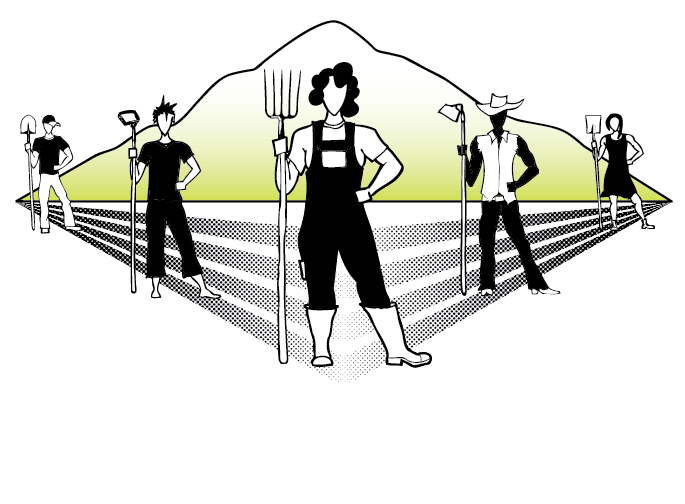Equipment Sharing
For as long as expensive equipment has existed in farming, so have communities who have joined together to jointly own, lease, or otherwise share that equipment.
Sharing equipment might not make or break a farm business, but it certainly can alleviate some of the financial stress of investing into pricey resources. One study in Sweden found that even when using equipment at non-optimal times, farmers still saved 15%+ in costs by participating in an equipment cooperative.
Many farmers engage in informal equipment sharing, but there are legal and social benefits to establishing a more formal arrangement. There are many ways this sort of arrangement can be established. Read below to learn about successful models from around the world, and find templates, guidebooks, and more about starting an equipment sharing collective of your own!
Spotlight on the Intervale farmer equipment company
The Intervale Center (IC) is a nonprofit based in Vermont that houses several innovative projects: they run a food hub and a conservation nursery growing native plants, provide farm business technical assistance, and own farmland that is leased out to several farm businesses.
Originally, the IC owned and operated all farm equipment onsite. In 2005, the Intervale Farmer Equipment Company (IFEC) was formed: an LLC jointly owned by the farmers and the nonprofit. The equipment (tractors, implements, and greenhouses) were sold to the LLC. The farmers jointly contributed cash contributions equal to about 65% of the value, while the IC contributed the remaining 35%.
Members of the IFEC pay by hour for tractor and implement use, and by bench for greenhouse use. They are required to contribute work hours towards maintaining and repairing equipment.
Read more about the management structure of the IFEC, including how repairs, training, and billing are handled, via this fact sheet.
cumas: an international cooperative equipment sharing model
A CUMA (Coopérative d'Utilisation de Matériel), translated to Agricultural Equipment Cooperative, is a model of cooperative farm equipment ownership that originated in France. The concept is ubiquitous in the region—nearly half of all French farmers are part of a CUMA.
The CUMA office requires at least one meeting per year for members, but groups are free to come up with their own guidelines for sharing. Many smaller cooperatives run very casually, where larger cooperatives tend to be more organized, with some hiring an employee or purchasing land to store the equipment.
Equipment sharing cooperatives are far less common in the United States—but they don’t have to be! Aspects of the model could be readily replicated in different communities. Read more about CUMAs in the resources dropdown below.
A guide to sharing farm equipment
A project of NE SARE, this publication by Faith Gilbert is an ultimate all-in-one guide for farmers interested in sharing equipment.
The guide includes profiles on six different existing models of equipment sharing (including direct co-ownership, cooperative ownership, NGO programs, and government programs).
It walks readers through how to create an equipment sharing program, and includes templates for operation, maintenance, and administration.
More Resources for Sharing Equipment
-
Template: Letterbox Farm Customizable Equipment Sharing Agreement | Letterbox Farm
Manual: Machinery Sharing Manual for Fruit and Vegetable Growers | Iowa State University, 2009
Dividing Costs: Equipment Sharing Calculator | Iowa State University, 2023
Sample Worksheet: Forming a Joint Machinery Venture | Iowa State University, 2023
-
California Plowshares
A 25-member equipment sharing collective in the Santa Barbara region, California Plowshares owns and shares harvesters, a compost spreader, seed cleaners, a no-till drill, a berm flamer, and a foliar spray trailer. The collective was started by two farmers who wanted to invest in equipment necessary to process grain and seed.
Article: California Plowshares | SBCFAN, 2022
Article: Breaking Barriers & Ground: How Equipment Sharing Empowers Small-Scale Farmers in California | CalClimate Ag, 2023
--
Tool Legit
Based in North Carolina, Tool Legit began as many equipment sharing collectives do: with a group of farmers informally sharing resources, building relationships, and eventually deciding to formalize the system. The collective formed an LLC over a decade ago, and has pooled resources and won grant funding to invest in equipment.
Article: The Farmers Leaning on Each Other's Tools | Civil Eats, 2024 (also features California Plowshares, CUMAs, and Faith Gilbert's equipment sharing guide)
--
AgriShare
Unlike other equipment sharing models, AgriShare happens online. Founder Paul Zaake launched the service to make resources more readily available to small farmers in Uganda. AgriShare operates an app, website, and call center where farmers can find equipment and land to rent.
Article: Revolutionizing Agriculture: The Story of Paul Zaake’s Innovative Rental App for Small Farmers in Uganda | Medium, 2023
-
Oregon Soil and Water Conservation District Equipment Sharing/Rental Spreadsheet
Across Oregon, different Soil and Water Conservation Districts offer pieces of equipment to rent. Check out the spreadsheet to see what might be available near you.
Underwood Conservation District Farm Tool Library
The UCD Farm Tool Library offers handheld farm tools like broadforks, axes, and saws, as well as larger equipment like manure spreaders and plows. The library serves the Columbia Gorge area.
-
Article: How Farmers Benefit from Ag Equipment Co-ops | CooperativesFirst, 2018
Article: 50% of all French farmers are in CUMA machinery sharing | Irish Farmers Journal, 2023
Academic Article: An intensive and collective style of farm work that enables the agroecological transition: A case study of six French farm machinery cooperatives | Veronique Lucas & Pierre Gasselin, 2022


